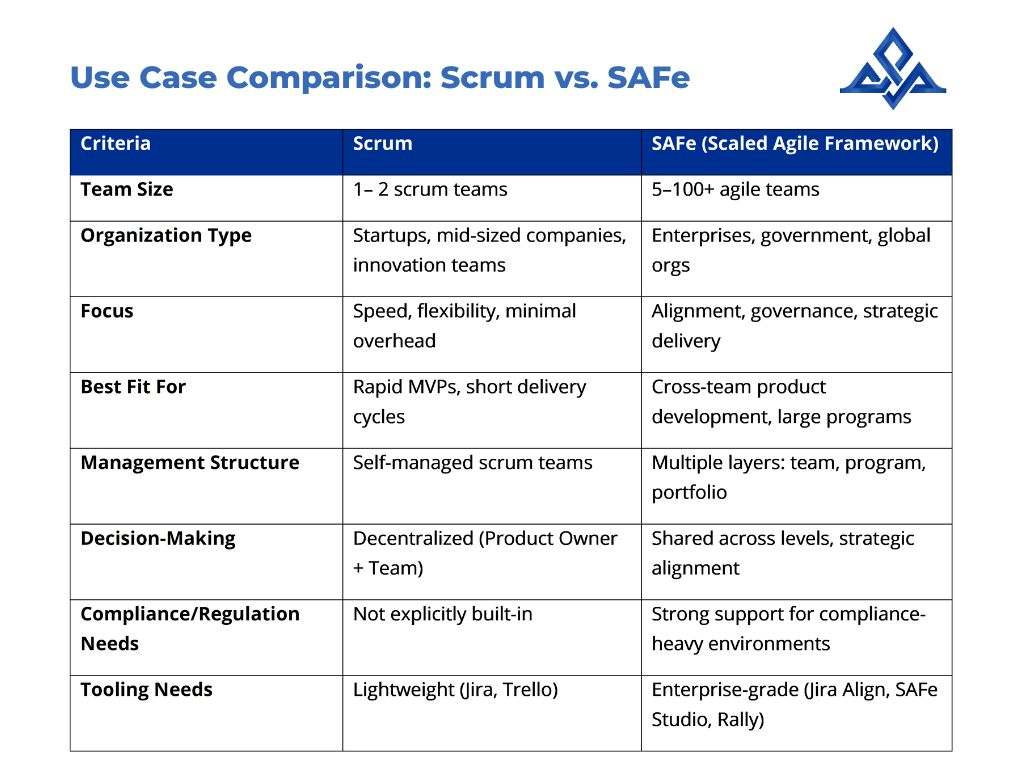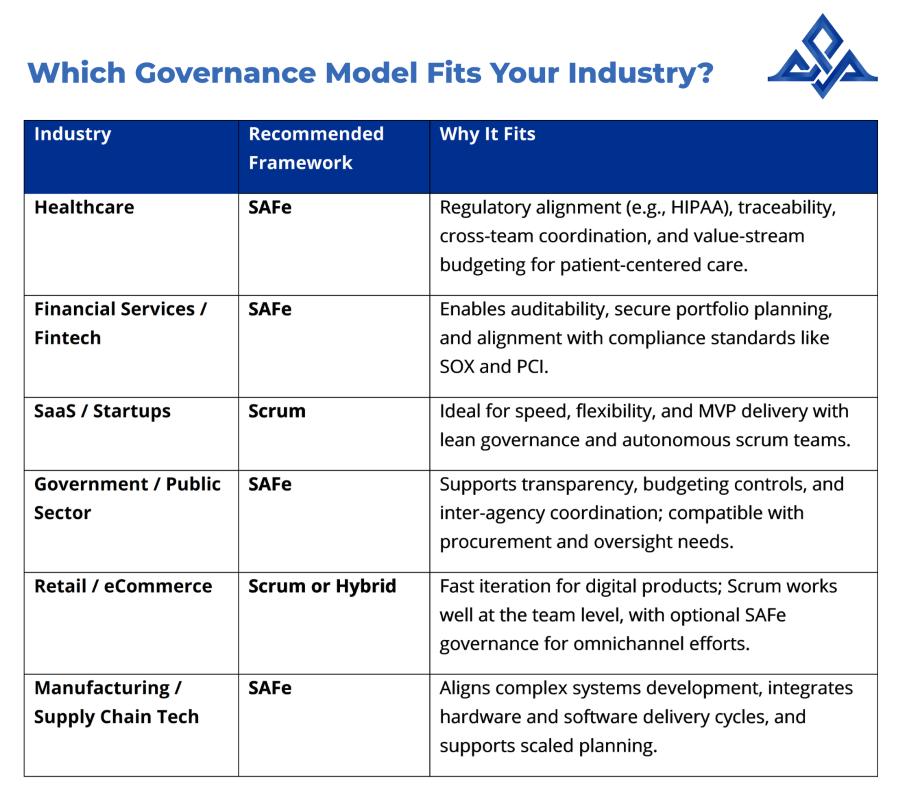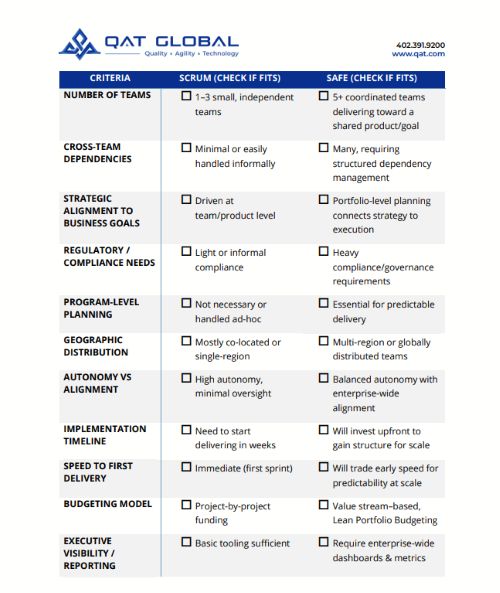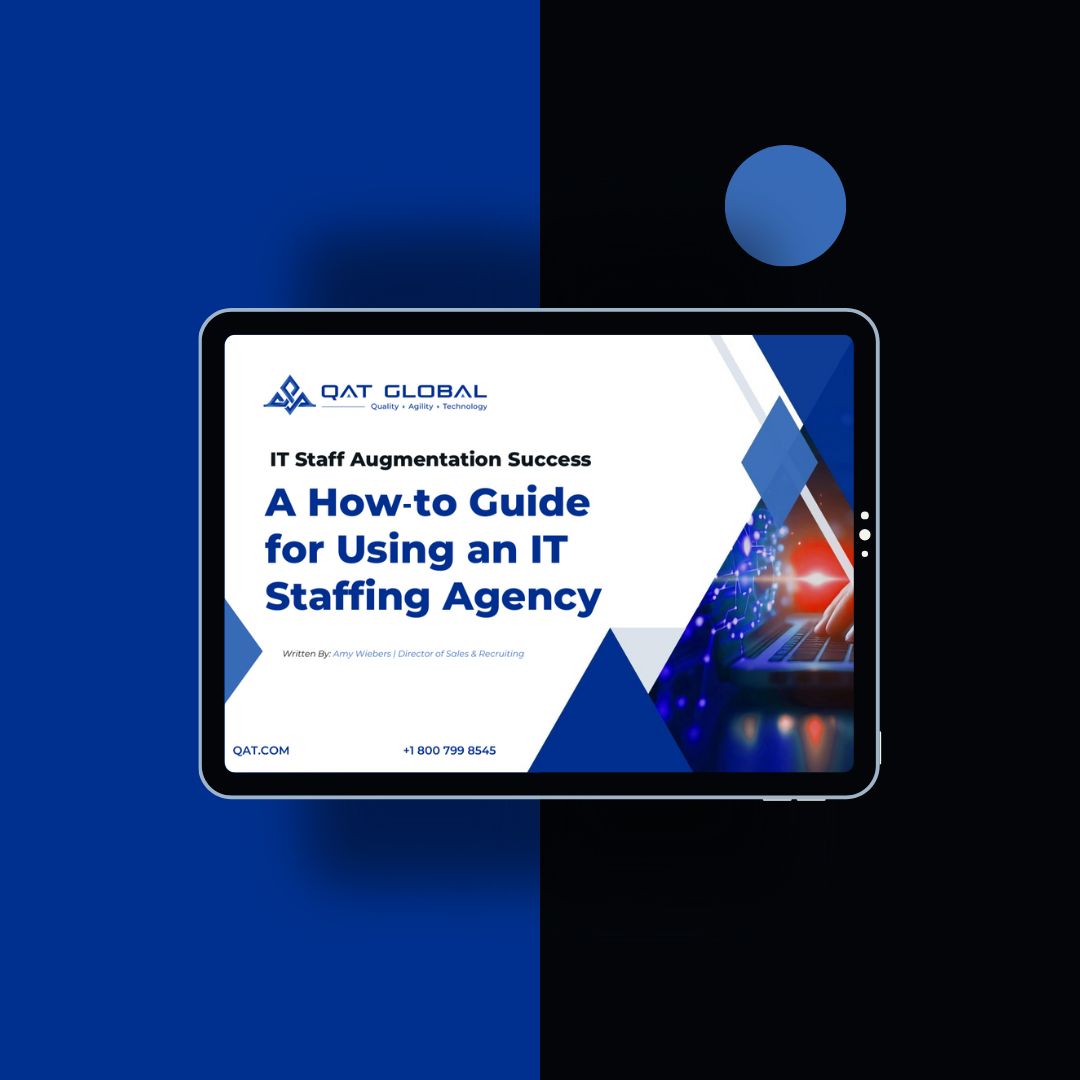SAFe vs Scrum
In the complex landscape of modern software development, the quest for efficiency and adaptability often leads organizations down a rabbit hole of methodologies.
If your team has ever felt like it’s drowning in a sea of agile frameworks, buzzwords, and conflicting advice—you’re not alone. And more importantly, you’re not wrong to feel frustrated.
Here’s what many discussions gloss over: choosing the wrong agile framework isn’t just a theoretical misstep—it can derail your entire delivery strategy. From ballooning costs and delayed product launches to fragmented teams and lost customer trust, the risks are real. This isn’t just about process. It’s about performance, predictability, and protecting your bottom line.
This article aims to cut through the noise, revealing what most comparisons between Scrum and SAFe (Scaled Agile Framework) aren’t telling you—and why these distinctions matter now more than ever. If your framework doesn’t match your structure, goals, or complexity, you’re setting your teams up to fail before the first sprint even begins. It’s not about choosing the ‘best’ agile framework—it’s about choosing the right one for the complexity you’re facing.
By the end, you’ll walk away with a clearer understanding of each agile framework’s strengths, limitations, and ideal fit—empowering you to make confident, high-stakes decisions that accelerate delivery instead of dragging it down.
What Is Scrum? What Is SAFe?
Scrum is an agile framework for managing complex projects, emphasizing iterative progress, collaboration, and flexibility. Teams work in short cycles called Sprints (typically 2–4 weeks) to deliver incremental value. Since its formalization in the early 1990s, Scrum is now one of the most widely adopted agile methods globally, with usage reported in over 90% of agile teams according to the State of Agile Report. Its simplicity, clear roles, and structured events have made it the foundation for many scaled agile frameworks used today.
Scrum Roles:
- Scrum Master: Facilitates the Scrum process, removes impediments, coaches the team.
- Product Owner: Owns the product backlog, prioritizes work, maximizes value.
- Scrum Team: Cross-functional group responsible for delivering increments of work.
As agile adoption grew within large enterprises, the need to coordinate across multiple Scrum teams gave rise to scaling frameworks—among which SAFe (Scaled Agile Framework) has become the most prominent. SAFe is a comprehensive framework designed to scale agile practices across large organizations. It builds on Scrum, Lean, and Kanban principles and adds layers of coordination, planning, and governance for multiple teams working toward common business goals.
As of today, SAFe is the most widely adopted scaling framework, used by over 50% of large enterprises practicing agile at scale. Its emphasis on aligning strategy with execution has made it especially appealing to industries that require governance, compliance, and cross-functional coordination.
SAFe Roles:
- Release Train Engineer (RTE): Scrum Master at the program level, facilitates Agile Release Train (ART) execution.
- Product Manager: Owns the program backlog, defines features, aligns with business goals.
- Solution Manager: Manages capabilities and solutions at the large solution level.
- System Architect/Engineer: Provides architectural guidance and technical enablement.
Where They Shine: SAFe for Scaling vs Scrum for Speed
When Speed Matters, When Scale Wins
Scrum is excellent for driving speed and agility within small, focused teams. This agile framework fosters rapid iteration, quick feedback loops, and team autonomy. It’s ideal for startups or product teams that need to move fast, learn quickly, and continuously adapt to customer input.
SAFe, by contrast, is a robust scaled agile framework designed for large enterprises. It enables alignment, coordination, and synchronized delivery across many teams working on complex, interdependent software solutions. While it introduces more roles and structure than Scrum, it provides the governance and visibility needed to manage portfolio-level initiatives and deliver business value at scale—without losing the spirit of agility.
Use Case Comparison: Scrum vs. SAFe

A Few Important Realities to Consider
For example, a SaaS startup with one Scrum team building a standalone product benefits from Scrum’s simplicity and speed. But a Fortune 500 enterprise delivering an integrated platform across dozens of cross-functional Scrum teams may need SAFe’s coordination layers to keep teams aligned, ensure compliance, and deliver at scale without chaos.
Team Dynamics: Flat vs Hierarchical Collaboration
Scrum: Self-Managed, Minimal Hierarchy
- At the heart of Scrum is the idea that the best decisions come from the people closest to the work. Scrum teams are self-managed, cross-functional, and empowered to organize their own workflows.
- With minimal hierarchy—just the Product Owner, Scrum Master, and Developers—Scrum encourages collaboration, rapid feedback, and shared ownership.
- For software teams, this means fewer bottlenecks and more agility to respond to change, whether that’s a shifting customer need or a technical challenge mid-sprint.
But Scrum’s lean structure isn’t always easy to adopt in organizations accustomed to top-down management. In some enterprise settings, cultural resistance surfaces when former project managers struggle to relinquish control, or when executives expect predictability without embracing the iterative nature of agile delivery.
SAFe: Coordination Layers and Agile Release Trains
- As software efforts scale across multiple teams, things get more complex. That’s where SAFe comes in. SAFe adds structure through coordination layers—like Agile Release Trains (ARTs)—to align teams working toward a shared goal.
- These ARTs sync teams on planning, priorities, and delivery cadence, all while keeping Agile principles intact. It’s a way to maintain flow, reduce cross-team friction, and ensure we’re all building toward the same outcomes—even when the scope grows big.
However, when these layers are misunderstood or misapplied, they can lead to the opposite of what SAFe intends—rigid workflows, bloated meetings, and confusion over decision rights. Inexperienced teams may revert to “command-and-control” behavior, undermining the collaborative intent of the framework.
How Autonomy and Alignment Shift with Complexity
- In smaller projects, autonomy is king. Teams can move fast and pivot without much overhead. But as complexity increases—think multiple products, stakeholders, or integrations—alignment becomes just as important.
- SAFe helps strike that balance by giving teams room to self-organize while also creating a common direction and cadence. The goal isn’t to control how teams work, but to make sure the work fits together, delivers value, and avoids rework or surprises down the line.
Challenges in Culture Shift and Communication
- One of the biggest hurdles in scaling Agile isn’t process—it’s mindset. Moving from a traditional structure to Agile at scale means rethinking how we lead, communicate, and make decisions.
- Teams need trust and clarity, not micromanagement. Communication must be constant, transparent, and two-way. For software teams used to autonomy, scaling can feel like added layers—but when done right, it enables better delivery, not more red tape.
Here’s a common culture clash: In many enterprises transitioning to SAFe, teams accustomed to status reporting find it difficult to engage in collaborative backlog grooming or participatory planning. Leaders may misinterpret ceremonies like PI Planning as status meetings instead of alignment events—diluting their effectiveness and causing tension between business and technical stakeholders.
The key is building a culture where alignment doesn’t mean control—and where collaboration beats command.
Sidebar: Top 3 Cultural Clashes in Agile at Scale
- Command-and-Control Leadership vs. Empowered Teams
Leaders used to top-down decision-making often struggle with the transparency and autonomy Scrum and SAFe require—leading to micromanagement or undermining team trust. - Status Meetings Masquerading as Agile Ceremonies
PI Planning and Scrum events are designed for collaboration and alignment, not reporting. When misused, they become bloated status updates that drain momentum. - Functional Silos vs. Cross-Functional Collaboration
Departments that resist sharing ownership across product, dev, and QA teams create bottlenecks and kill agility. Agile frameworks demand shared goals and continuous collaboration.
Fix It Fast: Build a communication culture where feedback flows both ways, planning is participatory, and alignment is about value—not control.
Governance & Autonomy: Who Decides What?
In SAFe, Lean Budgeting is a core concept. Funding is allocated to Value Streams (aligned with customer outcomes) rather than individual projects. Teams within a Value Stream have some budget autonomy but operate within the constraints of portfolio-level funding decisions. This approach supports better customer alignment by tying investment directly to value delivery. For instance, a financial institution building a multi-channel customer platform can fund a single Value Stream focused on the full customer journey—spanning multiple teams, technologies, and product lines—all working under one aligned budget.
In SAFe, decision rights are distributed across levels. Strategic decisions—such as portfolio priorities and funding—are made at the Portfolio or Program level, while teams have autonomy within defined boundaries for things like PI objectives. This ensures cross-team alignment while maintaining agility at the delivery level. Critically, SAFe’s structure is also designed to support regulatory and traceability needs—enabling organizations in compliance-heavy sectors to align with frameworks like HIPAA, SOX, or GDPR while still delivering in agile cycles.

Tip: If your organization faces external audits or must align delivery to customer-facing compliance outcomes, SAFe’s lean governance may offer the structure you need—without sacrificing agility.
Tooling & Ceremonies: What’s Involved
Agile frameworks rely on structured ceremonies and the right tooling to maintain focus, coordination, and visibility across teams.
Scrum emphasizes fast feedback, continuous improvement, and shared ownership through its core ceremonies:
- Sprint Planning: The Scrum Team collaborates to define the Sprint Goal and select backlog items to deliver.
- Daily Scrum: A brief, 15-minute stand-up where the team synchronizes efforts and identifies blockers.
- Sprint Review: At the end of each Sprint, stakeholders review what was delivered and provide feedback for future planning.
- Sprint Retrospective: A team-only session focused on reflecting on the past Sprint to identify improvements in collaboration, tools, or process.
These ceremonies foster rhythm, transparency, and adaptability—making Scrum especially well-suited for small to mid-sized teams that thrive on collaboration and quick pivots.
SAFe introduces higher-order ceremonies that enable coordination across multiple agile teams:
- PI (Program Increment) Planning: A large-scale, two-day event that aligns all teams within an Agile Release Train (ART) around shared objectives and timelines.
- ART Sync: A regular coordination meeting for Product Owners, Scrum Masters, and stakeholders to ensure alignment across teams during execution.
- Inspect & Adapt (I&A): A recurring event to evaluate progress, identify systemic issues, and implement improvements at the program level.
These ceremonies promote transparency and cross-team alignment, which are critical in scaled agile environments with complex interdependencies and strategic planning needs.
Tool Ecosystem Comparison: SAFe-Centric Tools
The following tools are built or adapted specifically for implementing SAFe at scale:

SAFe vs Scrum for Small Projects: Lean & Mean or Overkill?
Real Work Scenario: Lego
LEGO began its agile journey at the team level with Scrum, but found that individual agile teams still struggled with effective cooperation across the enterprise.
SAFe Implementation:
- They adopted SAFe to introduce an ART (Agile Release Trains) and eventually scaled to the portfolio level. They held regular PI Planning sessions.
- 20 product teams met every eight weeks for a one-and-a-half-day planning session to showcase work, hash out dependencies, estimate risks, and plan for the next release period.
Results:
- Improved cooperation and alignment across multiple teams.
- Reduced excessive documentation due to self-management.
- More accurate estimation and prediction, leading to easier decision-making.
- The team benefited from having face-to-face communications; and a more visual, gamified, and focused planning process.
Word of Advice: Safe vs Scrum for Small Projects
When managing small projects, choosing the right agile framework can mean the difference between agility and administrative overload. Scrum is often the preferred approach for its simplicity, speed, and clear structure. Scrum offers a lean, focused way to deliver value quickly. For small teams tackling concise goals, Scrum keeps things moving without unnecessary complexity.
SAFe is designed to coordinate multiple teams working on large-scale initiatives. While powerful for enterprise environments, applying SAFe to a small project can add an unnecessary overhead. It introduces layers of roles, planning cycles, and governance that may overwhelm a small team and hinder delivery. SAFe might be overkill in these scenarios.
SAFe vs Scrum for Large Projects: Chaos or Control?
How SAFe Brings Order to Complexity
The Scaled Agile Framework (SAFe) was designed to help organizations manage the chaos that arises when Agile is applied at scale.
In large enterprises, where multiple teams work on interconnected projects, traditional Agile methods can fall short in aligning goals, managing dependencies, and delivering cohesive value. SAFe brings order to this complexity by introducing a layered structure—team, program, large solution, and portfolio levels—that provides clear roles, responsibilities, and synchronization points. Through mechanisms like Program Increments (PIs), Agile Release Trains (ARTs), and Lean Portfolio Management, SAFe ensures that strategic priorities are communicated top-down and feedback loops are enabled bottom-up. This structure provides predictability while retaining the flexibility of Agile, creating a disciplined yet adaptive operating model.
QAT Tip:
Before you scale with SAFe, make sure that your individual teams have fully embraced agile values and reached a baseline level of maturity in their practices. SAFe magnifies both strengths and weaknesses, so strong team agility is a must.
Leadership buy-in is essential for SAFe success. Executives must clearly communicate the strategic reasons for adopting SAFe, champion the transformation, and ensure teams understand the value of aligning around programs and business outcomes.
When to Choose Which: A Decision Framework
The decision between Scrum and SAFe isn’t just about team preference—it’s about aligning your agile framework with your organization’s size, goals, complexity, and compliance needs. The following guidelines and scorecard can help assess fit.
- When there are more than 5–9 agile teams working on the same product.
Scrum is designed for single, small teams. SAFe is better suited when coordination across many teams is essential. - There is a need to align business strategy with execution across the enterprise.
SAFe offers Portfolio Management and strategic themes that connect high-level goals to team-level work—Scrum does not operate at this scale. - There are complex inter-team dependencies.
If teams frequently block each other or rely on shared components, SAFe provides structured planning (like PI Planning) to manage and align dependencies. - The organization is delivering large, integrated systems or products.
For initiatives involving multiple technologies, platforms, or regulatory environments, SAFe enables governance, compliance, and integration at scale. - There is a need to require program-level planning and cadence-based delivery.
SAFe synchronizes teams using Agile Release Trains (ARTs) and Program Increments (PIs) to deliver on a predictable cadence—Scrum doesn’t offer a native mechanism for multi-team synchronization. - Consistent practices are needed across distributed or global teams.
SAFe helps enforce consistent roles, ceremonies, and metrics across a large or geographically dispersed workforce. - The organization demands higher visibility and governance.
Upper management often requires structured reporting and predictable delivery, which SAFe supports through Lean-Agile budgeting, metrics, and centralized planning.
QAT Tip:
If you find yourself checking boxes mostly under SAFe for your context, it’s likely time to explore a scaled agile framework more seriously. But if flexibility, autonomy, and rapid delivery are your top priorities—Scrum might still serve you best.
FAQs
Next Steps
Choosing the right agile framework—whether Scrum, SAFe, or a hybrid—can be the difference between accelerating delivery or adding friction. When you understand your team’s maturity, delivery goals, and coordination needs, the decision becomes clear.
Ready to scale with confidence? Schedule a no-pressure consultation to explore the best-fit agile delivery approach for your team.

















